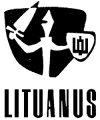Editor of this issue: Thomas Remeikis
Copyright © 1964 LITUANUS Foundation, Inc.

|
LITUANUS
LITHUANIAN
QUARTERLY JOURNAL OF ARTS AND SCIENCES
Volume 10, No.3-4 - Fall and
Winter 1964
Editor of this issue: Thomas Remeikis ISSN 0024-5089
Copyright © 1964 LITUANUS Foundation, Inc. |

|
Book Review
A COLLECTION OF MATERIALS ON SOCIAL AND ECONOMIC HISTORY OF LITHUANIA
Lietuvos TSR Mokslu Akademija. Istorijos Institutes. LIETUVOS INVENTORAI XVII a.: DOKUMENTU RINKINYS (Inventories of Lithuania of the XVII Century: A Collection oi Documents), compiled by | K. Jablonskis and M. Jucas, Vilnius: Valstybine Politines ir Mokslines Literatuios Leidykla. 1962. 463 pp.
The inventories of great estates in
the Grand Duchy of Lithuania, taken during the sixteenth-eighteenth
centuries, are important sources of Lithuanian history which have not
been adequately analized and utilized so far. Some work in this
direction was already done during the independence period by the late
historian K. Jablonskis, one of the compilers of this collecion. In
1934 he had prepared the collection Istorijos Archyvas, XVI Amžiaus
In-ventoriai. Historians of other countries also have previously
published estate inventories, mostly in Russian collections. Lithuanian
historians, such as J. Totoraitis and Z. Ivinskis, have used in their
studies some of the existing and hitherto unpublished inventory
materials.
The present collection is a valuable contribution to social and economic history of Lithuania in that it includes about a third of the available inventories of the seventeenth century. Inventories of 115 estates, arranged chronologically, are included in the collection. Excluded from the collection are inventories of state estates and church holdings. The published inventories cover private boyar estates. They provide detailed descriptions of estate buildings, landholdings, forests, pastures, and farm animals. The peasantry and the number of families are listed, their property, lands, feudal obligations, and occupations described. Economic conditions, and trade in the villages are very much in evidence. Inventories of some estates were taken repeatedly after several years, thus providings information on economic changes and development.
The inventories are published in their original language, mostly in Polish and occasionally in Russian, without any changes in the original language. The inventories were selected from the files of ancient acts in the Central Archives of Lithuania. Manuscript departments of the Library of Vilnius University, the Library of the Academy of Sciences, and the State Library were also used.
This collection is valuable not only to the historians but also to linguists and ethnographers. It is evident that the Lithuanian names predominate in the lists of peasants, even in those districts where many consider the Lithuanian element as not predominant, e.g. Vilnius area.
Each inventory was taken by a different person. The inventories are thus lacking in consistency or common outline. Lack of systematic treatment of the subject, however, makes for a more interesting reading. Perhaps most interesting are the detailed discriptions of towns, registering every house according to streets, e.g. such is the description of the estate and town of Kėdainiai.
The geographic area covered by the inventories is ethnic (not historic) Lithuania. Thus a number of inventories are from localities presently within Belorussian territory.